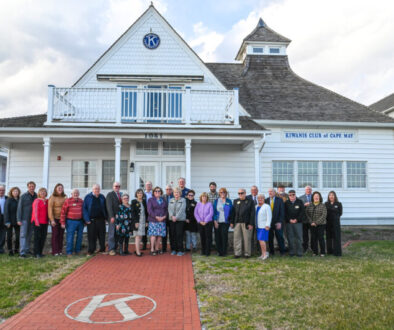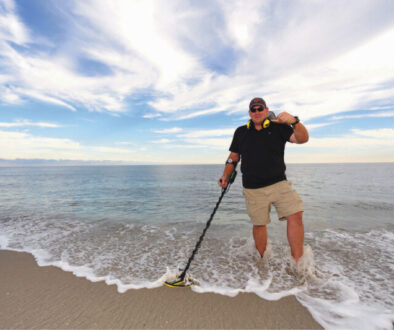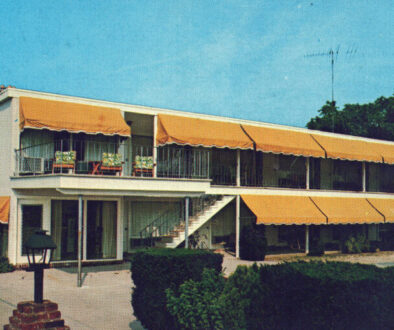Harry Bellangy

I had hoped to meet Cape May historian Harry Bellangy over coffee or to sit on a park bench. Instead, Harry insisted on meeting at the home of the Greater Cape May Historical Society. It’s the building commonly known as Colonial House and was built in 1730 to operate as a tavern. It was also the home of Revolutionary War hero Memucan Hughes.
As I approached the house, beside City Hall on Washington Street, I saw Harry looking out one of the wavy 18th-century window panes. He serves as President of the Historical Society, which has maintained the house as a museum of colonial-era Cape May. Harry met me at the door and escorted me to the back exhibit room, a treasure trove of historical documents, faded maps, towers of archival boxes, and old photos. The rare artifact that caught my eye and made my heart skip a beat was a displayed copy of Ho! For Cape Island! a book considered to be the Holy Grail of Cape May for all historians. It is a book so rare, I have only known of two people in my life who have owned copies. It was clear to me why Harry wanted to be in his natural environment.
Oh, wow! You have Ho! For Cape Island!
You already touched on something! You just said, “Oh, you have.” You’re not going to find anywhere else in Cape May that has that book. You’re also not going to find every single Pennywise that has ever been printed. (Pennywise was a weekly publication from 1937 until the late 1970s. It featured photos and stories of visitors and locals, out and about in Cape May, a forerunner to Exit Zero.) It was nothing more than a throw-away publication that you might have looked at once to see who was doing what and that was it. But these hundreds of issues make up a 50-year narrative of daily life in Cape May. We are currently going after grant money to properly transcribe it to other formats and perhaps reprint. That’s just one example of the history that we have that you won’t find anywhere else. This is what gets me so excited about history. There is a huge amount of Cape May history which has always leaned toward Victoriana. There is other stuff that happened here in Cape May that nobody talks about.
I bet I’d find it right here in this room.
You are correct. That’s the kind of thing we have. I took this from an organization that was talking solely about colonial-era to an organization that is dedicated to preserving all of Cape May history. People come in here who have seen Victoriana, but they know that something else happened. They even ask me what it was like to grow up here.
Are the archives here used to aid historians and researchers?
It happens on a regular basis. For example, just this past year the city knocked down a house on St. Johns Street which should not have been demolished. It was a contributing historic structure. There was a lady who we were working with from Architectural Heritage Consultants who was required by the state to make a story map which shows there was once a vibrant African American community here on various sites. We helped her with the needed photos and documents to create her map.
Why did the city tear it down?
That’s where the new police station is going.
How will the story map prevent other buildings from being torn down?
It won’t. Sadly, the creation of the map is the result of that historic building being demolished that should never have been demolished. The map will now aid the state in memorializing that site with a plaque which will tell of the site’s importance to the African American community.
Has the destruction of that building put Cape May’s Historic Landmark status in jeopardy with the Department of the Interior?
(Harry takes a deep breath) Not yet.
There have been so many myths and inaccuracies over the years regarding our history. I’ve heard narration from passing carriage tours that sound fantastically entertaining but far from historically accurate.
I’ve written to them from the museum saying, “I would be very happy to help you with the content of your tours.” Crickets. No response. No interest. None. If you are going to represent Cape May on a tour, you have a responsibility to do it correctly. They claim on their tours there is a tunnel from the Wisteria Cottage to Congress Hall. I’d like to see that! It’s irresponsible to perpetuate these sorts of myths, and it degrades Cape May’s rich history. False stories make the town seem like a theme park. As if next you’d hear someone announce the Abbey by saying, “Oh, look there’s Cinderella’s castle!”
Why do you think people perpetuate such myths on a tour?
Because it sells the product. You can still have fun and tell entertaining stories on a tour while explaining our history accurately. MAC is very successful at tours that are both historically accurate and entertaining.
Would you say that MAC has mastered the art of finding new ways to present Cape May on their tours?
Absolutely. I’ll give you an example. The day we were inaugurating a tour with MAC which explained the history of the Negro baseball teams years ago—it showed where they stayed, where they played, what the social climate was like and so on. Mary Stewart was doing a wonderful narration on the trolley tour, and I was along for the ride. I was looking around and thinking to myself, “Good grief, this town is gorgeous.” We don’t always notice it when we live and work here, but that MAC tour ended up presenting the most stunning things in a fresh way.
Were you as fascinated with Cape May history growing up here as a kid?
Nope. I didn’t become interested in Cape May history until urban renewal began tearing down buildings in the 1960s. I saw what was being demolished and that it was all being done to make money. I have a box of newspaper articles here about what was going on at the time and it reads like a horror story. If urban renewal had been successful and had this town not remained Victorian, I wouldn’t be here right now.
Are local children nowadays interested in our town’s history?
It doesn’t seem like it. But I’m glad you asked that because we’re about to work with a guy who is a retired teacher, and we plan on taking programs to schools. We’re also in the process of publishing a children’s book which looks at life in a town very similar to Cape May.

What’s the biggest threat today to the future of Cape May in your mind?
Decreasing population. We’re down to about 2600 year-round residents. When I was growing up there were about 6500, which were mostly families.
What’s the direct danger to Cape May from a decreasing population?
We lose voters. The few voters we have are mostly elderly. The voter demographic is not very diverse. These factors can often skew the vote.
Tell me about when you left Cape May after high school.
I went to college for teaching, and I hated it. But then I discovered computers which were very good to me. I worked in Wilmington, Delaware as a programmer for Wilmington Trust. I eventually got involved in medical information systems, of all things, and spent about 15 years doing that. I moved back to Cape May out of concern for my mother’s health and landed a job in the casino industry. After seven years of that, I worked with IBM as a senior systems architect and retired with them.
Do you have a specific aspect of history that fascinates you most?
Pipe organs!
Do you play?
Badly! They are fascinating devices. My attraction to them is the sound and the variety of music you can get from them. The technology in them is incredible.
What is Cape May’s best pipe organ?
The one at the Presbyterian Church used to be. They have replaced it with one which no longer incorporates the pipes. But the best pipe organ right now in Cape May is at the Episcopal Church. The one at the old Allen A.M.E church is wonderful too.
Wasn’t that damaged by the fire a few years ago?
No, thank goodness, other than the fact that it’s dirty and needs to be cleaned. That is a tracker organ, meaning that when you press the key, it moves the rod that pulls the valve that opens the pipe and makes it go “toot.” That organ was introduced with much ceremony in 1921. Helen Porter, a pianist who the auditorium at the city elementary school is dedicated to, played at the inauguration of it and the papers reported that “respectable white people” attended the concert in a black church. I have the old newspaper article.
Will they keep the organ now that they are renovating the building for East Lynne Theater?
They are supposed to. And it’s completely restorable. I have done an assessment of it and I can certainly recommend the people who can come in and do it. I was instrumental in saving the world’s largest pipe organ in Atlantic City. I got involved with that one after I was involved in the restoration of the organ at the Broadway theater in Pitman.
I also know you have a soft spot for cats.
I do indeed! I’ve been involved with Animal Outreach now for over 20 years. I am the board chair. I grew up with cats. I think they’re fun, they’re different. I had cats that traveled with me from Washington when I used to come back home on the weekends. I had one that was leash-trained and would go up on the deck of the ferry when I was sailing over to Cape May. I have three cats; I had a fourth which recently died.
My friend Jane Menendez always says that cats and Cape May are like peanut butter and jelly. Have you ever been involved in addressing the feral cat issue in town?
We had an extensive program a few years back to spay and neuter cats. We had a very strong spay, neuter, release program going in Cape May. We had support from the city when they got money from the Dodge Foundation. The inmates up at Bayside Prison had built shelters and feeding stations. It’s still happening and there is still a very strong trap neuter return effort going on.
What’s your favorite example of Victorian-era architecture in town?
That is not a fair question but here goes. Let’s start with the Abbey and then I’d say the Mainstay and then the group of buildings on Columbia that Stephen Decatur Button designed. There ya’ go. They’re my favorites.
Any Cape May memories from childhood that are cool to tell?
Let’s see. Well, the first time I saw a television was on the sun porch of the Emlen Physick Estate when Dr. Sydney Newcomer and his wife lived there. They were close friends of my mother’s. In fact, I had a photograph of him that I sent to MAC and they did backflips when I sent it to them.
One final item so readers know just how native you are. You are a direct descendant of John Howland, isn’t that correct?
Correct. John Howland came over on the Mayflower and was a signer of the Mayflower Compact. He fell overboard during a storm in the Atlantic. He was miraculously pulled back on board. Cape May County has the largest number of Mayflower descendants outside New England. So, my family has been here for many generations, or as Jay Schatz often told people, “Harry’s family has been here since rocks were soft.”



